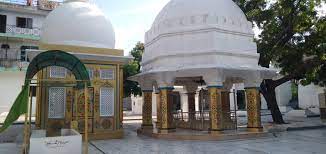
Nasiruddin Mahmud Chiragh Dehlavi (or Chiragh-e-Delhi) was born as Nasiruddin Mahmud Al Farooqi around 1274, at Ayodhya, Uttar Pradesh. Dehlavi's father, Yahya Al Farooqi, who traded in Pashmina, and his grandfather, Shaikh Yahya Abdul Latif Al Farooqi, first migrated from Khorasan, northeastern Iran, to Lahore, and thereafter settled in Ayodhya, in Awadh. His father died when he was nine, and he received education from Abdul Karim Sherwani and then from Iftikhar Uddin Gilani. At the age of forty, he left Ayodhya for Delhi, where he studied under Nizamuddin Auliya. Dehlavi stayed there for the rest of his life as his disciple, and after his death, became his successor. In time, he also became a known poet in Persian language. He died in 17 Ramzan 757 Hijri or 1357 AD, at the age of 82 or 83, and is buried in a part of South Delhi, India which is known as "Chirag Delhi" after him. One of his disciples was Bande Nawaz Gezu Daraz, who later moved to Daulatabad around 1400, owing to the attack of Timur on Delhi. Invited by Bahamani King, Firuz Shah Bahamani, he then moved to Gulbarga, Karnataka. He stayed there for the following 22 years, spreading the Chishti Order until his death in November 1422. During his stay in Delhi, Dehlavi visited Ayodhya, where he made many disciples, notably Shaikh Zainuddin Ali Awadhi, Shaikh Fatehullah Awadhi, and Allama Kamaluddin Awadhi. Kamaluddin Allama was his nephew and made him his successor. His successors are in Ahmedabad Gujarat, India. After his death, his tomb was built by Firuz Shah Tughluq (r. 1351 - 1388), the Sultan of Delhi in 1358, and later two gateways were added on either side of the mausoleum. One noted addition was a mosque built by a later Mughal emperor, Farrukhsiyar, in the early 18th century and popular among Muslims and non-Muslims. A humble tomb of the founder of the Lodhi dynasty (r.1451-89), lies close to the shrine, in the present-day locality of 'Chirag Delhi' that grew around the tomb since 1800, and still goes by his name, it is very close to the locality of Greater Kailash, in South Delhi.